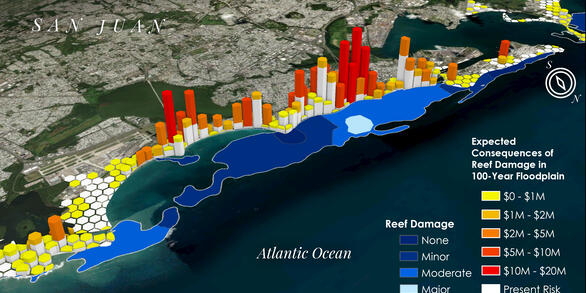Publications
Scientific reports, journal articles, and information products produced by USGS Pacific Coastal and Marine Science Center scientists.
Filter Total Items: 1382
Constraints on the development of Proterozoic basins in central India from 40Ar/39Ar analysis of authigenic glauconitic minerals
Ages of some key stratigraphic sequences in central Indian Proterozoic basins are based predominantly on lithostratigraphic relationships that have been constrained by only a few radioisotopic dates. To help improve age constraints, single grains of glauconitic minerals taken from sandstone and limestone in two Proterozoic sequences in the Pranhita-Godavari Valley and the Chattisgarh...
Authors
J. E. Conrad, J. R. Hein, A.K. Chaudhuri, S. Patranabis-Deb, J. Mukhopadhyay, G.K. Deb, N.J. Beukes
Assessing historical rate changes in global tsunami occurrence
The global catalogue of tsunami events is examined to determine if transient variations in tsunami rates are consistent with a Poisson process commonly assumed for tsunami hazard assessments. The primary data analyzed are tsunamis with maximum sizes >1m. The record of these tsunamis appears to be complete since approximately 1890. A secondary data set of tsunamis >0.1m is also analyzed...
Authors
E.L. Geist, T. Parsons
Channel evolution on the dammed Elwha River, Washington, USA
Like many rivers in the western U.S., the Elwha River, Washington, has changed substantially over the past century in response to natural and human forcing. The lower river is affected by two upstream dams that are slated for removal as part of a major river restoration effort. In preparation for studying the effects of dam removal, we present a comprehensive field and aerial...
Authors
A.E. Draut, J.B. Logan, M. C. Mastin
Observations of coarse sediment movements on the mixed beach of the Elwha Delta, Washington
Mixed beaches, with poorly sorted grains of multiple sizes, are a common and globally distributed shoreline type. Despite this, rates and mechanisms of sediment transport on mixed beaches are poorly understood. A series of tracer deployments using native clasts implanted with Radio Frequency Identifier (RFID) tags was used to develop a better understanding of sediment transport...
Authors
I.M. Miller, Jonathan Warrick, C. Morgan
Growth rate and age distribution of deep-sea black corals in the Gulf of Mexico
Black corals (order Antipatharia) are important long-lived, habitat-forming, sessile, benthic suspension feeders that are found in all oceans and are usually found in water depths greater than 30 m. Deep-water black corals are some of the slowest-growing, longest-lived deep-sea corals known. Previous age dating of a limited number of black coral samples in the Gulf of Mexico focused on...
Authors
N.G. Prouty, E.B. Roark, N.A. Buster, Steve W. Ross
Wave climate and trends along the eastern Chukchi Arctic Alaska coast
Due in large part to the difficulty of obtaining measurements in the Arctic, little is known about the wave climate along the coast of Arctic Alaska. In this study, numerical model simulations encompassing 40 years of wave hind-casts were used to assess mean and extreme wave conditions. Results indicate that the wave climate was strongly modulated by large-scale atmospheric circulation...
Authors
L. H. Erikson, C. D. Storlazzi, R. E. Jensen
Sediment dynamics and the burial and exhumation of bedrock reefs along an emergent coastline as elucidated by repetitive sonar surveys: Northern Monterey Bay, CA
Two high-resolution bathymetric and acoustic backscatter sonar surveys were conducted along the energetic emergent inner shelf of northern Monterey Bay, CA, USA, in the fall of 2005 and the spring of 2006 to determine the impact of winter storm waves, beach erosion, and river floods on biologically-important siliclastic bedrock reef habitats. The surveys extended from water depths of 4 m...
Authors
C. D. Storlazzi, T.A. Fregoso, N.E. Golden, D.P. Finlayson
Regional shoreline change and coastal erosion hazards in Arctic Alaska
Historical shoreline positions along the mainland Beaufort Sea coast of Alaska were digitized and analyzed to determine the long-term rate of change. Average shoreline change rates and ranges from 1947 to the mid-2000s were determined every 50 meters between Barrow and Demarcation Point, at the U.S.-Canadian border. Results show that shoreline change rates are highly variable along the...
Authors
Ann E. Gibbs, E. Lynne Harden, Bruce M. Richmond, Li H. Erikson
Effects of fringing reefs on tsunami inundation: American Samoa
A numerical model of tsunami inundation, Delft3D, which has been validated for the 29 September 2009 tsunami in Tutuila, American Samoa, is used to better understand the impact of fringing coral reefs and embayments on tsunami wave heights, inundation distances, and velocities. The inundation model is used to explore the general conditions under which fringing reefs act as coastal...
Authors
G. Gelfenbaum, A. Apotsos, A.W. Stevens, B. Jaffe
Nearshore Tsunami Inundation Model Validation: Toward Sediment Transport Applications
Model predictions from a numerical model, Delft3D, based on the nonlinear shallow water equations are compared with analytical results and laboratory observations from seven tsunami-like benchmark experiments, and with field observations from the 26 December 2004 Indian Ocean tsunami. The model accurately predicts the magnitude and timing of the measured water levels and flow velocities...
Authors
Alex Apotsos, Mark Buckley, Guy Gelfenbaum, Bruce Jaffe, Deepak Vatvani
The elusive character of discontinuous deep-water channels: New insights from Lucia Chica channel system, offshore California
New high-resolution autonomous underwater vehicle (AUV) seafloor images, with 1 m lateral resolution and 0.3 m vertical resolution, reveal unexpected seafloor rugosity and low-relief (
Authors
K.L. Maier, A. Fildani, C. K. Paull, S.A. Graham, T.R. McHargue, D.W. Caress, Mary McGann
Reconnaissance of Macondo-1 well oil in sediment and tarballs from the northern Gulf of Mexico shoreline, Texas to Florida
Hydrocarbons were extracted and analyzed from sediment and tarballs collected from the northern Gulf of Mexico (nGOM) coast that is potentially impacted by Macondo-1 (M-1) well oil. The samples were analyzed for a suite of diagnostic geochemical biomarkers. Aided by multivariate statistical analysis, the M-1 well oil has been identified in sediment and tarballs collected from Louisiana...
Authors
Robert J. Rosenbauer, Pamela L. Campbell, Angela Lam, T.D. Lorenson, Frances D. Hostettler, Burt Thomas, Florence L. Wong



